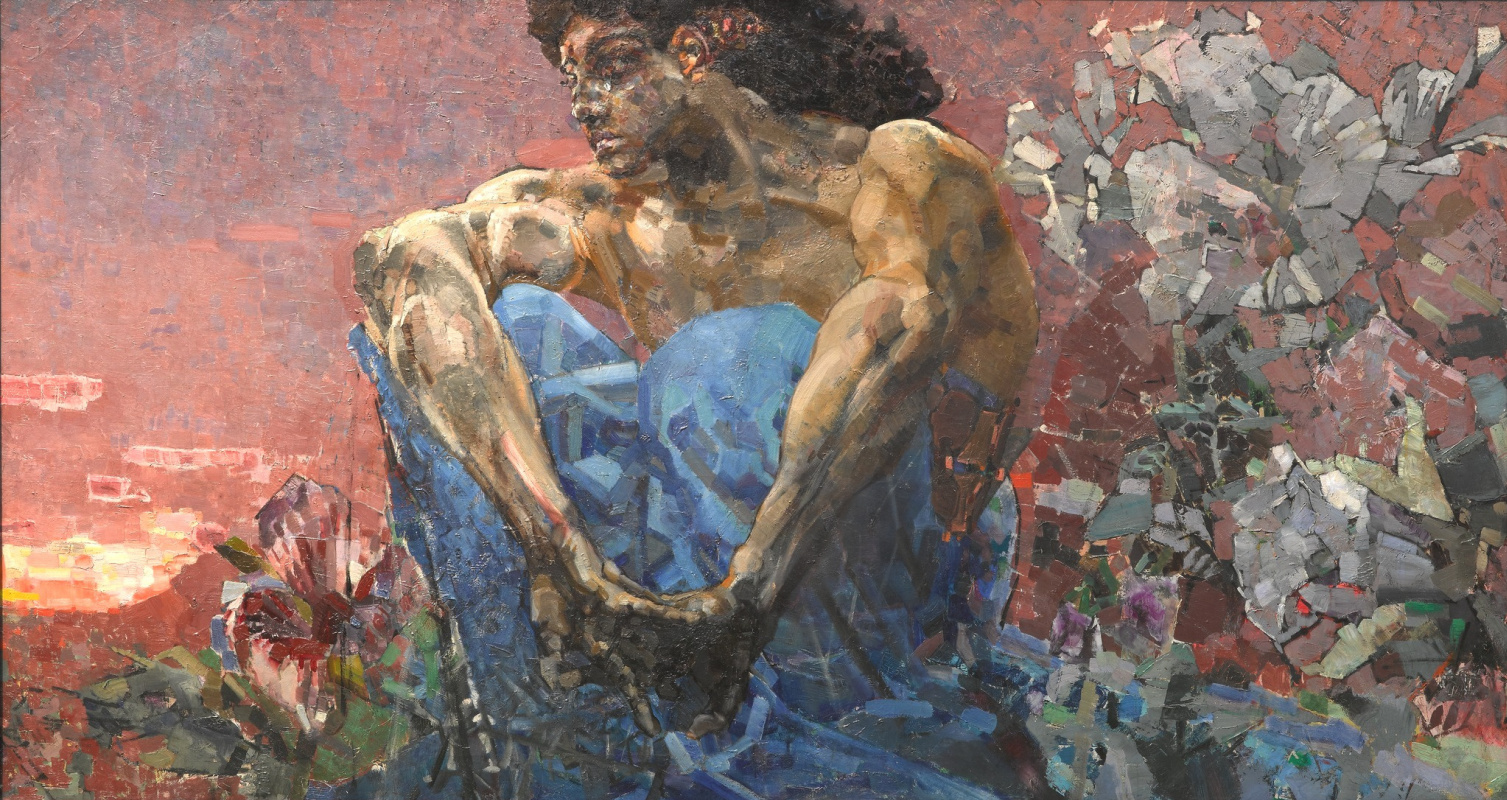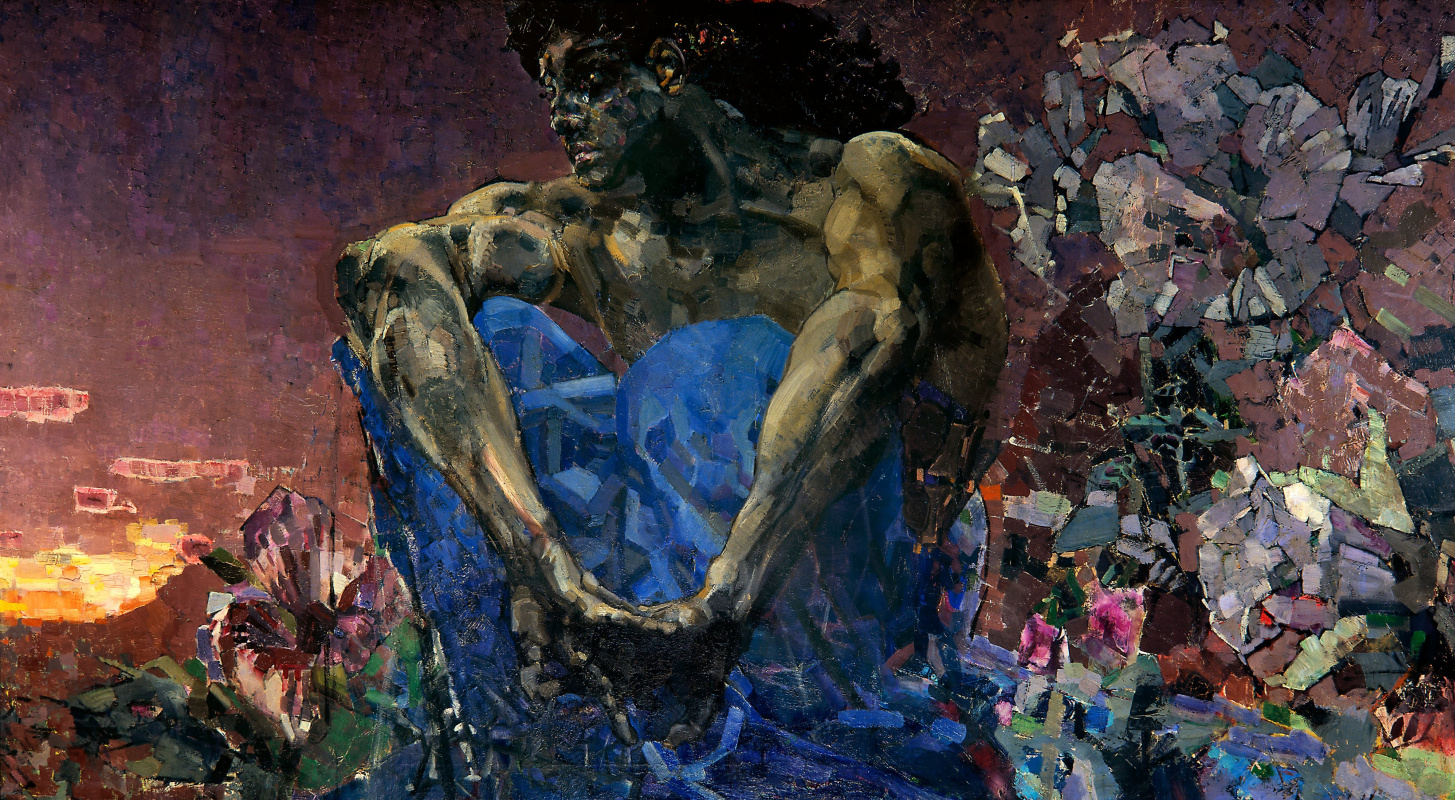log in
Enter site
Login to use Arthive functionality to the maximum
Demon sitting
Mikhail Aleksandrovich Vrubel • Malerei, 1890, 116.5×213.8 cm
Bildbeschreibung «Demon sitting»
Beginning in 1890, demons began to appear in Vrubel's work. It is noteworthy that he first turns to these images in Kiev, while working on the painting of the walls of the Cyril Church. Perhaps this was facilitated by the mental torment associated with the unrequited love for the wife of the customer of the painting, Emilia Prakhova.
Konstantin Korovin recalled how he once noticed terrible scars on Vrubel’s chest while bathing in a pond, to which he replied that in this way he tried to get rid of the torment of unhappy love: “I loved a woman, she didn’t love me - she even loved me, but much interfered her understanding of me. I suffered from the inability to explain this to her. I suffered, but when I cut myself, the suffering diminished. ”
To forget about the failures in the affairs of the heart, Vrubel goes to Odessa, where he embarks on a long-standing plan to write the Demon. One of the first versions of the picture (a half-length image of a Demon against a backdrop of mountains) was seen by the artist’s father, Alexander Mikhailovich, when he came to visit his son in Kiev. She disgusted him: "This demon seemed to me evil, sensual ... repulsive ... an old woman," he wrote. Vrubel Sr. expressed doubts that the painting would be successful with members of the Academy of Arts and ordinary art connoisseurs, and the artist destroyed the painting.
He again returns to the theme of demons while working on illustrations for Lermontov’s two-volume edition, which was scheduled for the writer's anniversary. On April 10, 1891, the publication saw the light of day, and immediately began to collect tough critical reviews in the press: Vrubel’s drawings were charged with “rudeness, ugliness, caricature, and absurdity”. Performed in black watercolor, in fact, they showed the artist’s virtuosity, his ability to express clearly with just two colors: black and white.
The appearance of the Demon in the illustrations for Lermontov’s poem resembles the appearance that Vrubel painted in parallel with them in the picture "Demon sitting". The artist talked about working on it in a letter to his sister Catherine: “I am writing to the Demon, that is, not only the monumental Demon, whom I will write over time, but the“ demonic ”- a half-naked, winged, young, sadly thoughtful figure sitting with her knees hugged , against the background of the sunset and looks at a flowering glade with which branches stretching under the flowers stretch to her. "
Vrubel worked on the sitting Demon in Moscow, in the house of the patron of arts Savva Mamontov. Serov recalled how he worked on the background of the picture: he obtained several photographs with mountain landscapes and laid them out in different sequences to imagine the perfect backdrop for a gloomy figure. Vrubel described his hero as follows: “A demon is not so much an evil spirit as a suffering and mournful one, with all this an imperious, majestic spirit.” His whole appearance is filled with strength: a muscular body, large features and a strong-willed chin, a powerful neck contrast with huge sad eyes and a womanly sensual mouth.
The whole picture is like one huge gem, shimmering in thousands of faces. This effect arises thanks to a special technique that the artist used: he applied paint with a palette knife with flat, wide and short strokes. Vrubel’s sister recalled that he was fascinated by the beauty of crystals during his studies at the gymnasium, where he grew them in natural science classes.
The demons did not leave Vrubel alone, and after years he will again and again return to this topic. In 1899 he writes "Demon flying": The picture was not finished, but a similar androgynous look is seen on it, as on a" sitting "version. And two years later, he begins work on "Demon defeated". In 1902, the painting took part in the exhibition of the art association "World of Art" in St. Petersburg. Vrubel was literally obsessed with the canvas and every morning, while there were few visitors, he came to rewrite it, erasing some colors and applying others, correcting the background and pose of his hero.
But most of all, the appearance of the last Demon did not give him rest. Alexander Benois wrote about the painful attempts of the artist to cope with an attack of perfectionism: “It is believed that the Prince of Peace posed for him. There is something deeply true in these terrible and beautiful, tearful, exciting paintings. His Demon remained faithful to his nature. He, who fell in love with Vrubel, nevertheless deceived him. These sessions were sheer mockery and mockery. Vrubel saw one side, then the other side of his deity, then immediately one and the other, and in pursuit of this elusive, he quickly began to move towards the abyss, to which he was pushed by the fascination of the damned. ”
Either the Demon completely drove the artist crazy, or the feverish work on the painting was a harbinger of an impending mental disorder, but soon after that Vrubel entered a psychiatric clinic and continued to be treated in various institutions until the end of his life.
The author: Natalia Azarenko
Konstantin Korovin recalled how he once noticed terrible scars on Vrubel’s chest while bathing in a pond, to which he replied that in this way he tried to get rid of the torment of unhappy love: “I loved a woman, she didn’t love me - she even loved me, but much interfered her understanding of me. I suffered from the inability to explain this to her. I suffered, but when I cut myself, the suffering diminished. ”
To forget about the failures in the affairs of the heart, Vrubel goes to Odessa, where he embarks on a long-standing plan to write the Demon. One of the first versions of the picture (a half-length image of a Demon against a backdrop of mountains) was seen by the artist’s father, Alexander Mikhailovich, when he came to visit his son in Kiev. She disgusted him: "This demon seemed to me evil, sensual ... repulsive ... an old woman," he wrote. Vrubel Sr. expressed doubts that the painting would be successful with members of the Academy of Arts and ordinary art connoisseurs, and the artist destroyed the painting.
He again returns to the theme of demons while working on illustrations for Lermontov’s two-volume edition, which was scheduled for the writer's anniversary. On April 10, 1891, the publication saw the light of day, and immediately began to collect tough critical reviews in the press: Vrubel’s drawings were charged with “rudeness, ugliness, caricature, and absurdity”. Performed in black watercolor, in fact, they showed the artist’s virtuosity, his ability to express clearly with just two colors: black and white.
The appearance of the Demon in the illustrations for Lermontov’s poem resembles the appearance that Vrubel painted in parallel with them in the picture "Demon sitting". The artist talked about working on it in a letter to his sister Catherine: “I am writing to the Demon, that is, not only the monumental Demon, whom I will write over time, but the“ demonic ”- a half-naked, winged, young, sadly thoughtful figure sitting with her knees hugged , against the background of the sunset and looks at a flowering glade with which branches stretching under the flowers stretch to her. "
Vrubel worked on the sitting Demon in Moscow, in the house of the patron of arts Savva Mamontov. Serov recalled how he worked on the background of the picture: he obtained several photographs with mountain landscapes and laid them out in different sequences to imagine the perfect backdrop for a gloomy figure. Vrubel described his hero as follows: “A demon is not so much an evil spirit as a suffering and mournful one, with all this an imperious, majestic spirit.” His whole appearance is filled with strength: a muscular body, large features and a strong-willed chin, a powerful neck contrast with huge sad eyes and a womanly sensual mouth.
The whole picture is like one huge gem, shimmering in thousands of faces. This effect arises thanks to a special technique that the artist used: he applied paint with a palette knife with flat, wide and short strokes. Vrubel’s sister recalled that he was fascinated by the beauty of crystals during his studies at the gymnasium, where he grew them in natural science classes.
The demons did not leave Vrubel alone, and after years he will again and again return to this topic. In 1899 he writes "Demon flying": The picture was not finished, but a similar androgynous look is seen on it, as on a" sitting "version. And two years later, he begins work on "Demon defeated". In 1902, the painting took part in the exhibition of the art association "World of Art" in St. Petersburg. Vrubel was literally obsessed with the canvas and every morning, while there were few visitors, he came to rewrite it, erasing some colors and applying others, correcting the background and pose of his hero.
But most of all, the appearance of the last Demon did not give him rest. Alexander Benois wrote about the painful attempts of the artist to cope with an attack of perfectionism: “It is believed that the Prince of Peace posed for him. There is something deeply true in these terrible and beautiful, tearful, exciting paintings. His Demon remained faithful to his nature. He, who fell in love with Vrubel, nevertheless deceived him. These sessions were sheer mockery and mockery. Vrubel saw one side, then the other side of his deity, then immediately one and the other, and in pursuit of this elusive, he quickly began to move towards the abyss, to which he was pushed by the fascination of the damned. ”
Either the Demon completely drove the artist crazy, or the feverish work on the painting was a harbinger of an impending mental disorder, but soon after that Vrubel entered a psychiatric clinic and continued to be treated in various institutions until the end of his life.
The author: Natalia Azarenko






